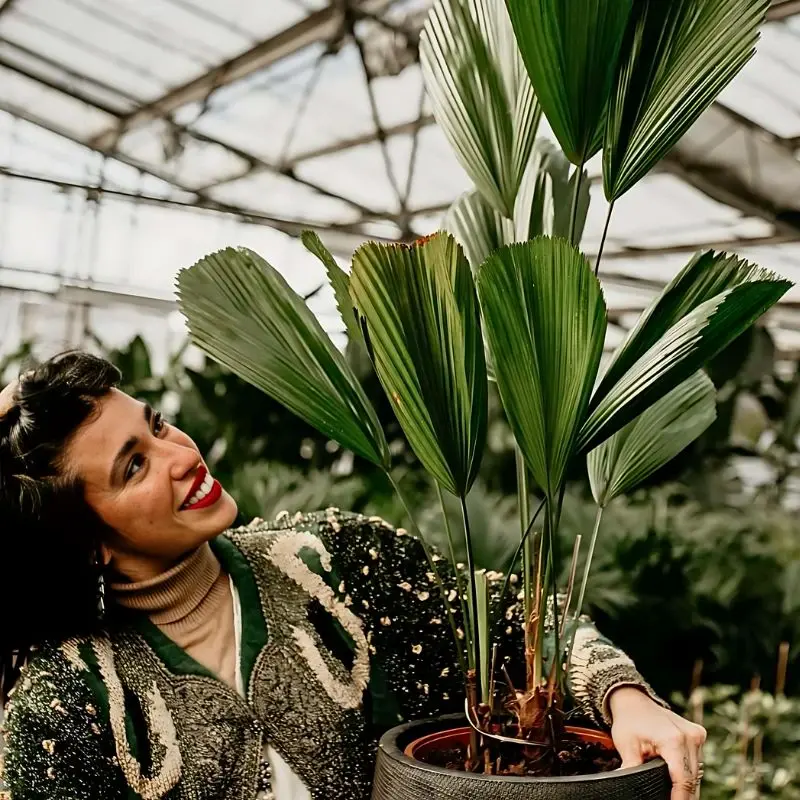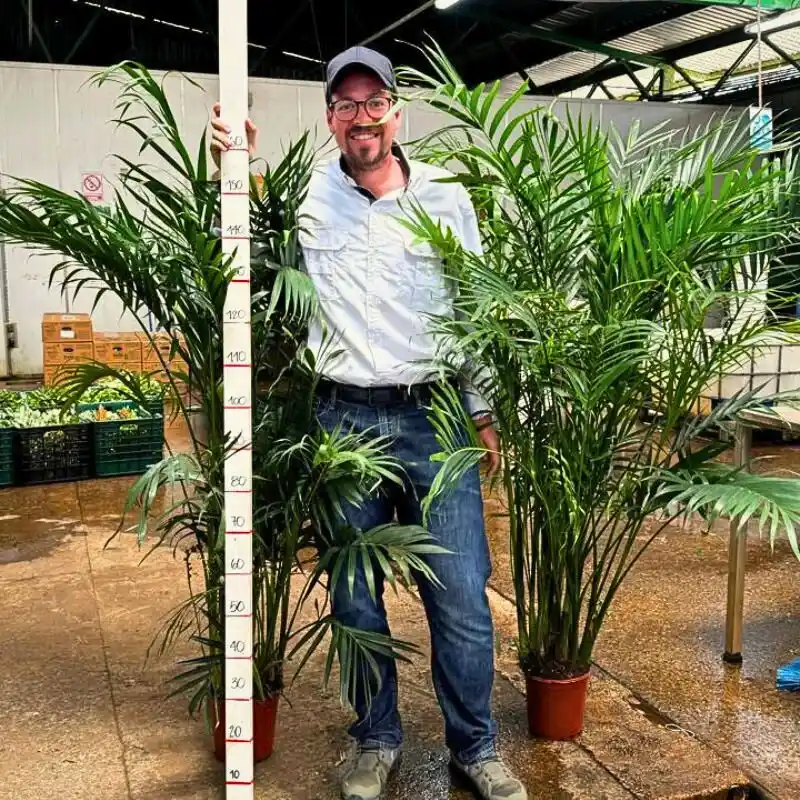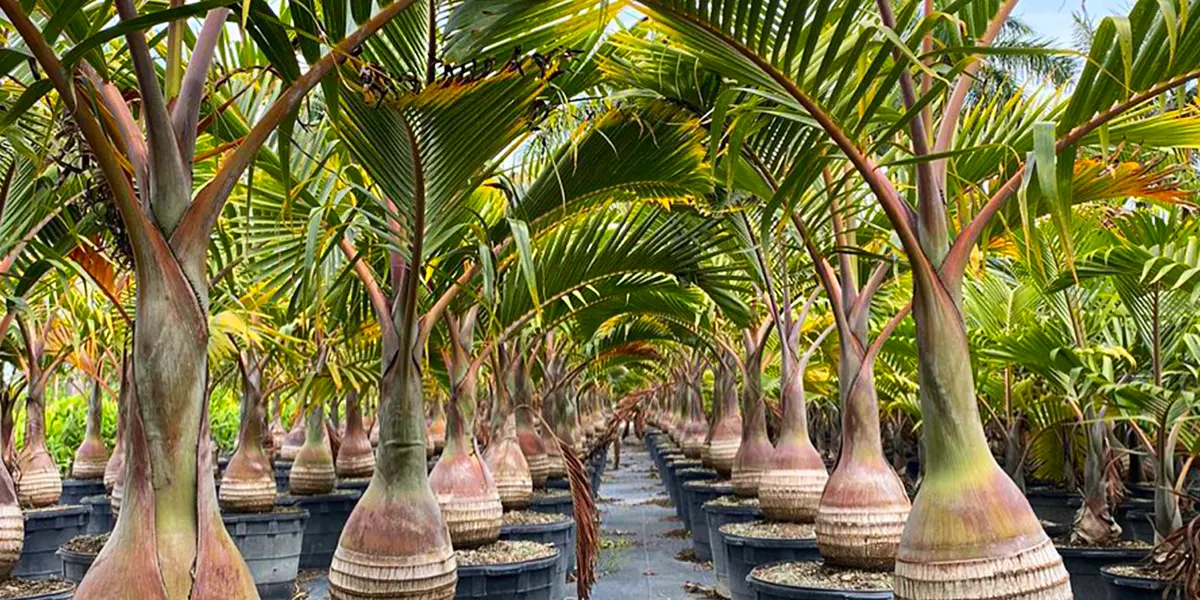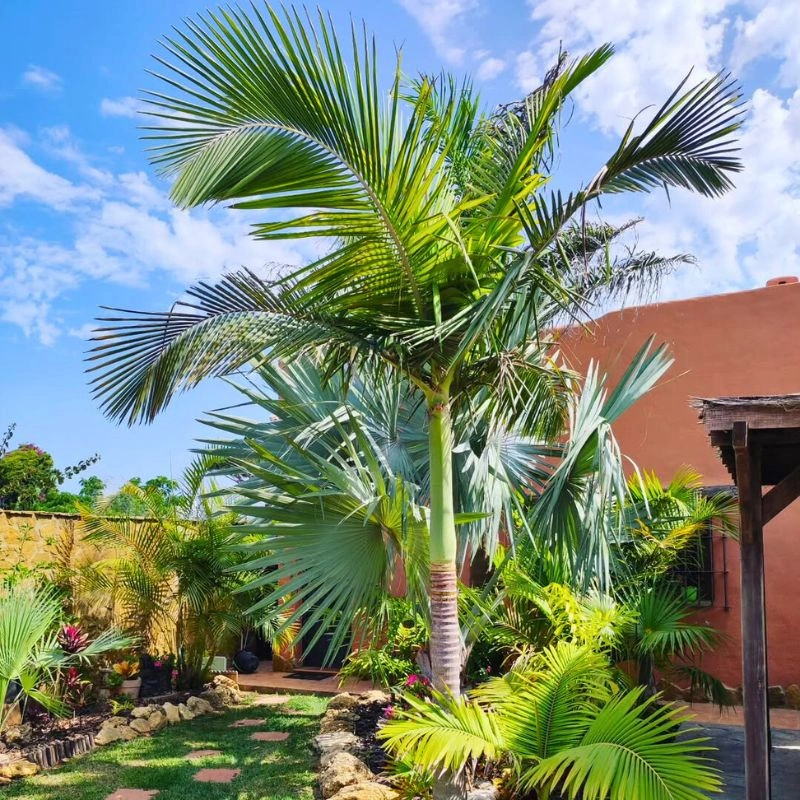The Lipstick Palm (Cyrtostachys renda), also known as the Red Sealing Wax Palm, is a stunning tropical plant native to Southeast Asia. With its bright red stems and deep green fronds, this slow-growing palm adds a touch of elegance to any indoor or outdoor space. This exotic and rare plant thrives in high humidity and makes a striking statement in gardens, landscapes, and indoor environments.
Choosing the Right Lipstick Palm
Selecting the right Lipstick Palm ensures its long-term health and optimal growth. Look for a plant with vibrant foliage and red stems, which are signs of a healthy lipstick palm. A healthy plant should also show new growth, indicating that it is actively developing.

Popular varieties such as the Palm Red Sealing Wax and Palm Exotic and Rare offer distinct features. Their deep green leaves and striking red trunks make them ideal for both indoor and outdoor settings.
Lighting and Temperature Needs of Red Sealing Wax Palm
The Lipstick Palm thrives in bright, indirect light, which supports its optimal growth. While it can tolerate partial sun, it will require frequent watering to maintain its lush appearance. However, exposure to full sun should be avoided, as it can lead to leaf scorch. To adapt to fluctuating sunlight, the lipstick palm adjusts its foliage orientation to enhance light absorption.

The ideal temperature range for this tropical beauty is 18-24°C (65-75°F), and high humidity is essential for its overall health. Additionally, it is highly sensitive to cold weather, anything below 12°C (55°F) is detrimental, so protecting it from frost is crucial, especially in cooler climates.
Watering Lipstick Palm
Proper water management for the Lipstick Palm is essential to maintain its health and growth. With its origin being the tropics and humid environs, keeping the soil moist without allowing standing water is crucial.
It’s best to allow the soil to dry slightly between waterings while maintaining 50-60% humidity for optimal growth, so water once every 1-2 weeks. If grown indoors, occasional misting can help increase humidity levels. In drier climates, special attention should be given to ensure the plant remains adequately hydrated, mulching is advisable upon watering to enhance moisture retention.
Best Soil and Fertilizer for the Red Sealing Wax Palm
Providing the right soil and nutrients is key to maintaining a healthy lipstick palm. A well-draining potting mix rich in organic matter is essential to support its growth while preventing waterlogging. The soil pH should be maintained between 6.0 and 7.0 for optimal nutrient absorption. In the event there is yellowing of fronds, chances are there is a likelihood of root rot, though often as a result of overwatering, the soil is majorly a contributor due to its poor drainage, so take note of this and adjust accordingly.

Applying a slow-release fertilizer every few months helps supply residual nutrients to support year-round growth. Always follow label instructions when applying fertilizer to ensure the proper quantity for the Lipstick Palm without over-fertilization.
How to Prune and Propagate Lipstick Palm
Regular pruning is essential for maintaining the shape and encouraging new growth of the Lipstick Palm. By trimming dead or damaged fronds, the plant can direct its energy toward healthy development. Regular pruning promotes enhanced air circulation and pest prevention.

When it comes to propagation, there are two primary methods: fresh seeds or division, both best done in spring or summer. Using fresh seeds requires patience, as germination is slow, often taking several months to sprout. Division, on the other hand, is a more efficient method, typically performed every 2-3 years, where mature clumps are carefully separated and replanted to establish new plants. Proper propagation techniques ensure a thriving, exotic, and rare red sealing wax palm that continues to enhance both indoor and outdoor spaces.
Repotting Your Lipstick Palm
Repotting your Lipstick Palm is essential for maintaining its health and encouraging growth. Ideally, repot every 2-3 years during spring or summer, or when the roots outgrow the current pot. Choose a container that is 5 to 10 centimeters (2-4 inches) larger in diameter, ensuring it has proper drainage holes to prevent waterlogging.

Use a well-draining yet moisture-retentive soil mix, such as a blend of peat, sand, and loam. To ease root removal, water the plant a day before repotting. Gently loosen the root ball, place the plant in the new pot, and fill it with fresh soil. After repotting, water thoroughly and maintain consistent moisture to help the plant adjust.
Overwintering Lipstick Palms
Overwintering lipstick palms is essential during winter to maintain their health and vigor. Bring it indoors to protect the plant from harsh cold temperatures that can hinder its growth. Reduce watering and fertilizing during colder months, as the plant's growth slows down, and excessive moisture can lead to root rot.

Place it in the brightest available light, preferably near an east—or south-facing window, to ensure it receives adequate sunlight. Additionally, avoid exposing the plant to cold drafts, as sudden temperature fluctuations can stress it and damage its leaves. Following these steps, the lipstick palm can thrive indoors and remain healthy throughout the winter.
Common Pests and Diseases Associated With Lipstick Palm
Lipstick palms are relatively resilient, but they can still fall victim to common pests and diseases if not properly cared for. Some of the most frequent pests include spider mites, mealybugs, and scale insects, which thrive in warm, dry conditions. Spider mites cause yellowing and stippling on leaves, while mealybugs leave behind a white, cotton-like residue and weaken the plant by sucking sap. Scale insects appear as small, hard bumps on stems and leaves, often leading to leaf drop. These pests can be managed with regular inspections, wiping leaves with a damp cloth, or applying insecticidal soap or neem oil.

In addition to pests, fungal diseases such as root rot can be a serious threat, especially if the plant is overwatered or sits in poorly draining soil. Root rot typically causes yellowing leaves, mushy roots, and stunted growth. To prevent this, ensure the soil is well-draining and allow the top layer to dry out between waterings. If root rot is detected, trimming affected roots and repotting the plant in fresh soil can help restore its health.

Regularly inspecting the roots of a lipstick palm is crucial for early detection of issues. Healthy roots should be firm and white, whereas diseased roots may appear black, brown, or mushy. Checking for foul odors can also indicate root rot. By staying vigilant and maintaining proper care, you can keep your lipstick palm free from pests and diseases, ensuring it remains vibrant and thriving.
Top Landscaping Uses of Lipstick Palm
A rare yet captivating addition to any landscape, Lipstick Palm (Cyrtostachys renda) is admired for its vibrant red stems and elegant foliage. Whether used as a focal point in a tropical garden or incorporated into modern minimalist designs, this striking palm brings a unique aesthetic appeal. Understanding its visual impact, placement strategies, and maintenance needs can help maximize its beauty and benefits in various outdoor spaces.

Lipstick Palm adapts beautifully to different garden styles, adding a striking visual element wherever it’s placed. In a tropical oasis, surrounding it with banana trees, hibiscus, and water features enhances its exotic appeal, creating a lush, tranquil escape. For a modern minimalist design, its bold red stems stand out against sleek stone walkways and neutral tones, offering a refined yet dramatic touch. In a cozy, natural setting, mixing it with soft, colorful blooms like lavender and daisies balances its vibrant presence, infusing charm and warmth. With proper care—including regular watering, nutrient-rich soil, and protection from harsh conditions—Lipstick Palm remains a standout feature in any landscape.
Lipstick Palm naturally draws attention, making it perfect for statement pieces in gardens. Placing it along pathways, near entryways, or as a central landscape feature highlights its bold red stems. Pairing it with complementary plants like bamboo, ferns, dark-leaved species, or bright flowering plants enhances its striking appeal while ensuring a cohesive look. For optimal growth, it thrives in bright sunlight but benefits from partial shade, especially with morning sun and afternoon shade to prevent excessive heat stress. Thoughtful positioning and companion planting maximize both its beauty and longevity.
Different Varieties of Lipstick Palms
There are three well-known varieties of Lipstick Palm, each offering unique aesthetic qualities. These include the iconic Red Sealing Wax Palm, the rare Exotic and Rare variety, and the Black Fruit variety, all of which enhance tropical landscapes in distinct ways.
The Red Sealing Wax Palm is the most popular, admired for its vivid red crown shafts and lush green foliage. It thrives in warm, humid environments and is often planted near water features for a striking visual effect.

The Exotic and Rare Lipstick Palm features distinctive white rings along its green trunk, adding a sophisticated contrast. Ideal for modern landscapes, it brings a unique architectural beauty to gardens.

The Cyrtostachys renda – Black Fruit Variety is notable for its deep green leaves and rare black fruits. Suited for wetland environments, it enhances tropical and pondside settings with its bold, exotic presence.

The Lipstick Palm is a rare and exotic plant that adds a vibrant touch to any space with its striking red trunk and lush green fronds. Whether placed indoors or outdoors, it enhances mood, boosts productivity, and creates a tropical ambiance. Proper care, including consistent watering, occasional misting, and well-managed soil moisture, ensures its lasting beauty.
Looking for Lipstick Palm for sale? Choose the perfect one and provide the best care to enjoy this stunning tropical gem all year round!










